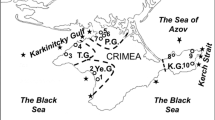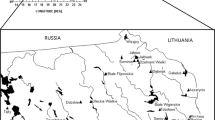Abstract
Investigations of 239+240Pu and 238Pu in the surface layer (0–5 cm) of bottom sediment in the Crimean 10 salt lakes from 4 geographical groups were carried out for the first time. The 239+240Pu varied widely between regional geographical groups of lakes as well as within groups too and ranged from 11±4 to 451±43 mBq239+240Pu/kg. The highest levels of 239+240Pu—419±27, 443±24 and 451±43 mBq/kg were observed in the Yevpatoriya (Lake Kyzyl-Yar), the Tarkhankut (Dzharylhach) and the Kerch group (Tobechik), respectively. The lowest values of 239+240Pu were identified in three lakes of the Perekop group and were 20±12, 24±6 and 48±6 mBq/kg. In all lakes 238Pu was an order of magnitude lower than 239+240Pu and varied from 4.8±2.6 to 30.7±5.5 mBq/kg. The 238Pu activity was decay-corrected to 1986. The characteristic ratio of the 238Pu/ 239+240Pu activities in the sediment and percentage of the Chernobyl-derived Pu was calculated. The largest percentages of the Chernobyl-derived Pu were observed in the Evpatoriya group (Lake Sasyk-Sivash)—16.2%±8.26%, the Tarkhankut group (Dzharylhach)—8.4%±2.10% and the Kerch group (Aktash)—10.5%±5.56%. The study of the depth distribution of plutonium in the Lake Kyzyl-Yar bottom sediment core (0–25 cm) was fulfilled. It was shown that 239+240Pu was high enough in all studied layers of bottom sediment, but the highest activity ratio 238Pu/ 239+240Pu (0.062±0.020) was found in the deepest layer of 15–20.5 cm and the percentage of Chernobyl-derived Pu was estimated at 6.8%±2.85% in this layer.
Similar content being viewed by others
References
Aarkrog A, Dahlgaard H, Foulquier L, Kutlakhmedov Yu, Kulebakina L G, Mytternaere С, Nielsen S P, Polikarpov G G. 1990. On the Variation of Radionuclide Ratios in Chernobyl Debris. In: Proc. Seminar on Comparative assessment of the environmental impact of radionuclides released during three major nuclear accidents: Kyshtym, Windscale, Chernobyl, 1–5 October 1990, Luxembourg. Report EUR No. 13574. p.507–519.
Alberts J J, Wahlgren M A, Orlandini K A, Durbahn C A. 1989. The distributions of 239,240 Pu, 238 Pu, 241 Am and 137 Cs among chemically–defined components of sediments, settling particulates and net plankton of Lake Michigan. Journal of Environmental Radioactivity, 9 (2): 89–100.
Anufrieva E V, Shadrin N V. 2014. Arctodiaptomus salinus (Daday 1885) (Calanoida, Copepoda) in saline water bodies of the Crimea. Mar. Ecol. J., 8 (3): 5–11. (in Russian)
Barjakhtar V G Chernobyl accident. 1995. Naukova dumka, Кiev. 473p. (in Russian)
Baskaran M, Miller C J, Kumar A, Andersen E, Hui J, Selegean J P, Creech C T, Barkach J. 2015. Sediment accumulation rates and sediment dynamics using five different methods in a well–constrained impoundment: case study from Union Lake, Michigan. Journal of Great Lakes Research, 41 (2): 607–617.
Eriksson M, Holm E, Roos P, Dahlgaard H. 2004. Distribution and flux of 238 Pu, 239,240 Pu, 241 Am, 137 Cs and 210 Pb to high arctic lakes in the Thule district (Greenland). Journal of Environmental Radioactivity, 75 (3): 285–299.
Gascó C, Antón M P, Pozuelo M, Clemente L, Rodríguez A, Yañez C, González A, Meral J. 2006. Distribution and inventories of fallout radionuclides ( 239+240 Pu, 137 Cs) and 210 Pb to study the filling velocity of salt marshes in Doñana National Park (Spain). Journal of Environmental Radioactivity, 89 (2): 159–171.
Gudkov D I, Derevets V V, Zub L N, Kaglyan A E, Kireev S I, Klenus V G, Kuzmenko M I, Kulachinsky A V, Machine V P, Nazarov A B, Savitsky A L. 2005. The Distribution of the radionuclides in the main components of lake ecosystems within the Chernobyl NPP exclusion zone. Radiatsionnaia Biologiia Radioecologiia, 45 (3): 271–280. (In Russian)
Gudkov D I, Kuzmenko M I, Shevtsova N L, Dsyubenko O V, Mardarevich M G. 2010. Damage in ecosystems with intensive radionuclide contamination of reservoirs. In: Romanenko V D ed. Technogenic radionuclides in fresh water ecosystems. Naukova dumka, Kiev, p.195–233. (in Russian)
Hanson W C. 1982. Errata: Transuranic elements in the environment. Journal of Ecology, 70 (1): 391.
Hardy E P, Krey P W, Nolchor H L. 1973. Global inventory and distribution of fallout plutonium. Nature, 241(5390): 444–445.
IAEA. 1989 Measurement of Radionuclides in Food and the Environment. Vienna: IAEA. 182p.
IAEA. 2005. Worldwide marine radioactivity studies (WOMARS) Radionuclide levels in oceans and seas. Vienna: IAEA. 187p.
Kuznetsov Yu V. 1991. Radioactive contamination in basin of the Dnieper River and Baltic Sea after the accident of Chernobyl NPP. Distribution and physical–chemical behavior of dose forming radionuclides, in: Comparative assessment of the environmental impact of radionuclides released during three major nuclear accidents: Kyshtym, Windscale, Chernobyl, Luxembourg. Report EUR 13574. p.467–479.
Lee S H, Gastaud J, La Rosa J J, Kwong L W, Povinec P P, Wysem E, Fifield L K, Hausladen P A, Di Tada L M, Santos G M. 2001. Analysis of plutonium isotopes in marine samples by radiometric, ICP–MS and AMS techniques. Journal of Radioanalytical and Nuclear Chemistry, 248 (3): 757–764.
Lukšienė B, Maceika E, Tarasiuk N, Koviazina E, Filistovič V, Buivydas Š, Puzas A. 2014. On peculiarities of vertical distribution of 239,240 Pu, 238 Pu and 137 Cs activity concentrations and their ratios in lake sediments and soils. Journal of Radioanalytical and Nuclear Chemistry, 300 (1): 277–286.
Lusa M, Lehto J, Leskinen A, Jaakkola T. 2009. 137 Cs, 239,240 Pu and 241 Am in bottom sediments and surface water of Lake Päijänne, Finland. Journal of Environmental Radioactivity, 100 (6): 468–476.
Mironov E G, Bessonov N P. 2015. Metrology and Technical Measurements: A Training Manual. Knorus, Moscow. 422p. (in Russian)
Nadytko B A, Timofeeva L F 2003. Plutonium. Fundamental problems. 2003. Sarov: RFYaC VNIIEF. 498p. (in Russian)
Oliferov A N, Timchenko Z V. 2005. Rivers and Lakes of Crimea. Dolya, Simferopol. 216p. (in Russian)
Pasynkov A A, Sotskova L M, Chaban V V. 2014. Ecological problems of conservation and use of balneological resources of salt lakes in the Crimea. Uchenye zapiski TNU im. V I Vernadsky. Geography, 27 (66)3: 96–116.
Perkins R U, Tomas K U. 1985. Global radioactive fallout. In: Transuranic elements in the environment. Ttranslation from English. Hanson U S ed. Energoaomizdat, Moskow. p.48–65. (in Russian)
Polikarpov G G, Egorov V N, Gulin S B, Stokozov N A, Lazorenko G E, Mirzoeva N Yu, Tereshchenko N N, Tsytsugina V G, Kulebakina L G, Popovichev V N, Korotkov A A, Evtushenko D B, Zherko N V, Malakhova L V. 2008. Radioecological response of the Black Sea to the Chernobyl accident. G G Polikarpov, V N Egorov eds. EKOSI–Gidrophisica, Sevastopol. 667p. (in Russian)
Ponizovskij A M. 1965. The salt resources of the Crimea. Crimea, Kiev. 164p. (in Russian)
Putyrskaya V, Klemt E, Röllin S, Astner M, Sahli H. 2015. Dating of sediments from four Swiss prealpine lakes with 210 Pb determined by gamma–spectrometry: progress and problems. Journal of Environmental Radioactivity, 145: 78–94.
Remeikis V, Gvozdaite R, Druteikiene R, Plukis A, Tarasiuk N, Špirkauskaite N. 2005. Plutonium and americium in sediments of Lithuanian lakes. Nukleonik a, 50 (2): 61–66.
Sanchez A L, Gastaud J, Noshkin V, Buesseler K O. 1991. Plutonium oxidation states in the southwestern Black Sea: evidence regarding the origin of the cold intermediate layer. Deep Sea Research, 38 (2): S845–S853.
Schertz M, Michel H, Barci–Funel G, Barci V. 2006. Transuranic and fission product contamination in lake sediments from an alpine wetland, Boréon (France). Journal of Environmental Radioactivity, 85 (2–3): 380–388.
Shadrin N V. 2008. The Crimean hypersaline lakes: general peculiarities. In: Tokarev Y N, Finenko Z Z, Shadrin N V eds. The Black Sea microalgae: problems of biodiversity preservation and biotechnological usage. ECOSIGidrofizika, Sevastopol. p.85–185.
Sotskova L M, Smirnov V O, Okara I V, Malischuk I O. 2015. Sokhraneniye balneologicheckikh resursov gryazevikh solenikh ozer zapadnogo Krima. Sovremenniye naychniye issledovaniya I innovatsii, 7 (4) URL: http: //web.snauka. ru/issues/2015/07/56691 (Accessed on 2017–02–08) (in Russian)
Talvitie N A. 1971. Radiochemical determination of plutonium in environmental and biological samples by ion exchange. Analytical Chemistry, 43 (13): 1 827–1 830.
Tereshchenko N N, Gulin S B, Proskurnin V Yu. 2016. Radioecological regularities of plutonium alpharadionuclides redistribution in the Black Sea ecosystem. Mar. Biol. J., 1 (3): 3–13. (in Russian)
Tereshchenko N N, Mirzoyeva N Y, Gulin S B, Milchakova N A. 2014. Contemporary radioecological state of the northwestern Black Sea and the problems of environment conservation. Marine Pollution Bulletin, 81 (1): 7–23.
Tereshchenko N N. 2000. Study of Pu and Am in bottom sediments of near–bottom and anthropogenic water systems and adjacent soils in the near zone of the Chernobyl NPP and in the south of Ukraine. In: Hygiene of inhabited places. Kiev. 36(I). p.414–419. (in Russian)
Tereshchenko N N. 2017. Effect of sea water trophic level on migration and deposition of man–made plutonium radionuclides. Journal of Siberian Federal University Biology, 10 (1): 20–34. (in Russian)
Trapeznikov A V, Molchanova I V, Karavaeva E N, Trapeznikova V N. 2007. Migration of radionuclides in freshwater and terrestrial ecosystems. II. Ural. c. 400p. (in Russian)
Ueda S, Ohtsuka Y, Kondo K, Hisamatsu S. 2009. Inventories of 239+240 Pu, 137 Cs, and excess 210 Pb in sediments from freshwater and brackish lakes in Rokkasho, Japan, adjacent to a spent nuclear fuel reprocessing plant. Journal of Environmental Radioactivity, 100 (10): 835–840.
Warner F, Harrison R M. 1993. Radioecology after Chernobyl: Biogeochemical Pathways of Artificial Radionuclides. Published on behalf of the Scientific Committee on Problems of the Environment (SCOPE)of the International Council of Scientific Unions (ICSU)by Wiley, Chichester New York. 400p.
Zheng J, Liao H Q, Wu F C, Yamada M, Fu P Q, Liu C Q., Wan G J. 2008. Vertical distributions of 239+240 Pu activity and 240 Pu/239 Pu atom ratio in sediment core of Lake Chenghai, SW China. Journal of Radioanalytical and Nuclear Chemistry, 275 (1): 37–42.
Acknowledgement
Investigation on the Crimean salt lakes was supported by the Russian Foundation for Basic Research Grant No. 16-05-00134. Investigation on the Black Sea areas was carried out within the framework of the state assignment on the direction of scientific research “The study of the mechanisms of adaptation, transformation and evolution marine and ocean ecosystems under climate change and anthropogenic influence” No. 1001-2014-0013.
Author information
Authors and Affiliations
Corresponding author
Rights and permissions
About this article
Cite this article
Tereshchenko, N.N., Proskurnin, V.Y., Paraskiv, A.A. et al. Man-made plutonium radioisotopes in the salt lakes of the Crimean peninsula. J. Ocean. Limnol. 36, 1917–1929 (2018). https://doi.org/10.1007/s00343-018-7312-5
Received:
Accepted:
Published:
Issue Date:
DOI: https://doi.org/10.1007/s00343-018-7312-5




